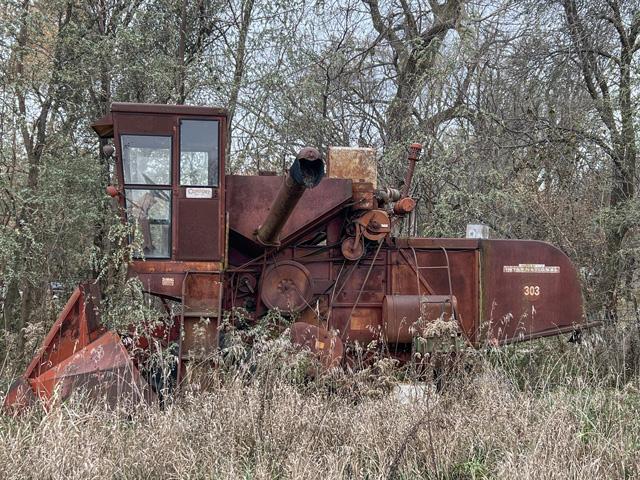Russ' Vintage Iron
More Talk on Vintage International Harvester Combines, Memories of the Machines
OMAHA (DTN) -- Well, I guess I should have written about vintage International combines a long time ago!
If you remember, last month I wrote about running some errands one day and coming across a vintage International Harvester (IH) 303 combine on a farm place. It was so rusty the red paint was almost all gone but the "303" decal was still visible on the back of the machine.
I attempted to write about some of the IH combines over the years and I missed some models. I received 20 emails about these combines and stories about them. Here is a sample of some of the emails. Thanks to everyone who added to the vintage IH combine conversation!
**
I enjoyed reading your recent column on vintage IH combines. I always enjoy your columns, especially when you write about IH equipment -- no offense to my John Deere, Gleaner or Massey friends.
We've always been IH fanatics on our farm. Grandpa worked at the IH plant in Hamilton, Ontario.
There are a couple of smaller early models that were not included in your column. In 1959, IH introduced the Model 91 combine. It was a small unit equipped with an 8.5-foot grain head. It could also be outfitted with a two-row corn head and an 8-foot pickup head.
This combine was unique because it had no steering wheel. It had levers for steering like a crawler or mini excavator. IH called the system "planetary steering." When the levers were pushed forward, the combine would go frontwards. When both levers were pulled back together, the combine would back up.
Pulling only one lever at a time would result in the machine turning right or left and it could turn "on a dime." These combines were produced from 1959 until 1962 at the same time as the bigger 03 series combines.
In 1963, IH updated the Model 91 with the Model 93. The 93 had some improvements over the 91, like a 10-foot grain head, more power and a steering wheel. The 93 could also be ordered with a cab. Both of these combines were built at the IH plant in Hamilton, Ontario, Canada.
I know quite a bit about the 91 combine because when I was a teenager, we had one on our dairy farm. We used it to combine small grains like oats, barley and mixed grain. Later, we combined soybeans with it.
At the time, they were a sweet little rig that made grain harvest a one-man operation as opposed to the grain binder and threshing machine. The only downside of the 91 combine was the absence of a cab.
At the end of a day of combining, I was filthy dirty from the dust, but Dad was happy with all the clean grain in the wagons.
Marty Rokowski
Ontario, Canada
**
I read your story and found it very interesting. I'm writing to let you know my dad bought a brand new IH 303 in 1965, I believe. It had a two-row-wide corn head and a 13-foot bean head. If my memory serves me correctly, he paid $9,000 for everything.
P[L1] D[0x0] M[300x250] OOP[F] ADUNIT[] T[]
Stuart Tuggle
**
We had a 403 combine and also a 402, which was a pull-type IH combine.
Interesting story. Thank you.
Lee Fraase
Buffalo, ND
**
Vintage IHC combines. You overlooked the 91 and 93 models, which were before 303. They were basically a No. 80 threshing unit with a motor and a transmission. The 91 steered with clutches; the 93 had a steering wheel and tie rods steering.
Ronald Chatt
**
I stumbled upon your article about vintage IH combines. Dad bought a 123 or 125 in the early '60s just to have something to start with if the custom cutters were late. I left the farm many years ago, but it was my first experience running a combine.
It had really small dual-drive wheels and took a 12-foot swath. Our neighbor had one just like it and once said it would get stuck if you peed on the tires. We soon decided it wasn't worth the trouble and to this day, it sits on the farm rusting away.
Neil Carlson
**
My parents bought a 105 IH open station combine back in 1967. It had a 10-foot grain head without any header height control. It was a four-cylinder. We did a lot of work with it.
Quite the chore to combine beans.
John Sachar
**
2577/88 followed 23 series. Flagship started with 8010, then included 7010, 88s, then there's 120s, 130s, 140s, 150s, 250s, maybe more. Don't know how they all intertwine.
Eric Turnquist
**
I had an IH 151 that had a cab. It was probably an aftermarket and not a factory cab. The 151 was a very good machine for its time.
Bob Sheetz
**
You forgot the 203 self-propelled International combine and then the 205. These two were the same machines: one had a four-cylinder engine and the other a six-cylinder (460) engine. Both came out in the 1960s.
Don't forget the 205 also.
Darren
**
You didn't mention the 203 and also the 315 combines. These were introduced in the respective years you mentioned for 03s and 15s. They were probably the biggest mistake IH made as the grain tanks hung side-saddle.
My dad ran both of these combines and then moved to a 303, which I still have. Then I bought a 715 and ran it until it dropped a valve and ruined the engine.
I bought a 1440 and ran it until antifreeze leaked into the crankcase and spun a rod bearing. I gave up on combines and hired neighbors to harvest after that. Now my son's preference is John Deere.
Pat Patenaude
Russ Quinn can be reached at Russ.Quinn@dtn.com
Follow him on X, formerly known as Twitter, @RussQuinnDTN
(c) Copyright 2023 DTN, LLC. All rights reserved.




